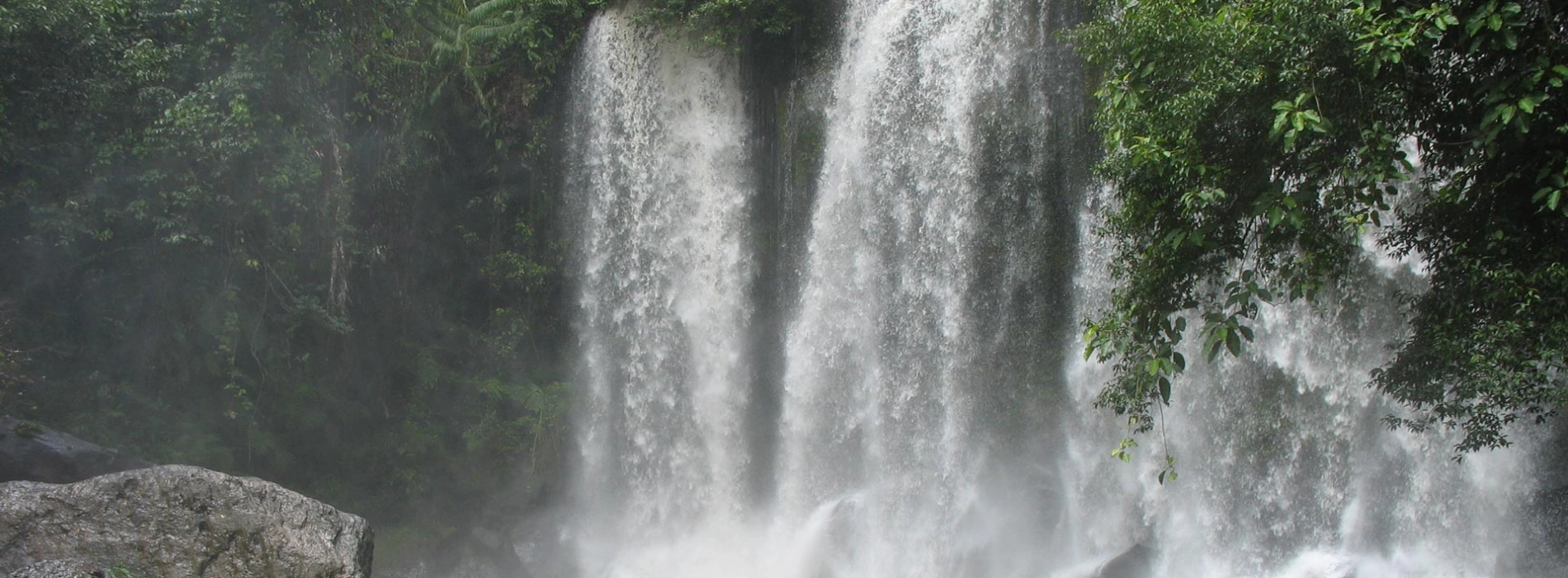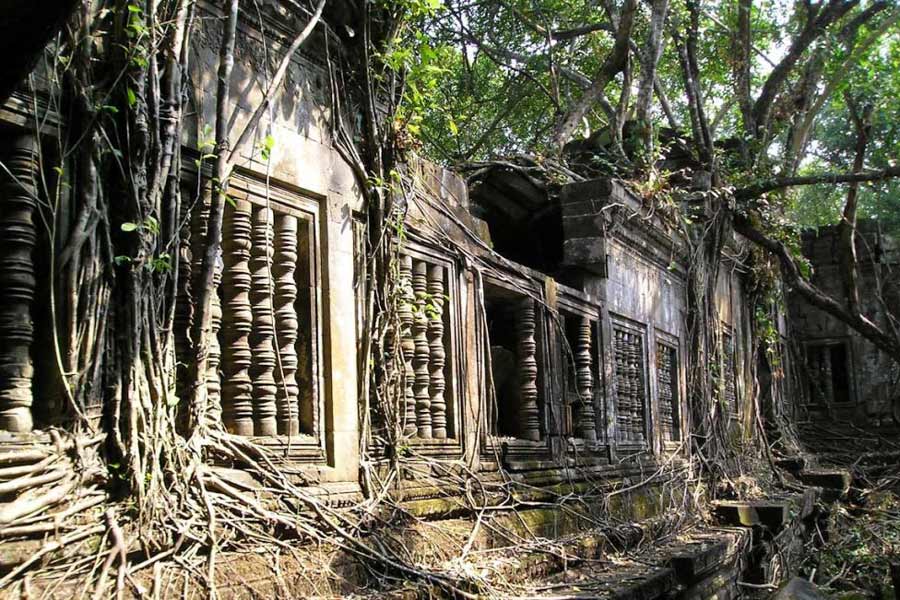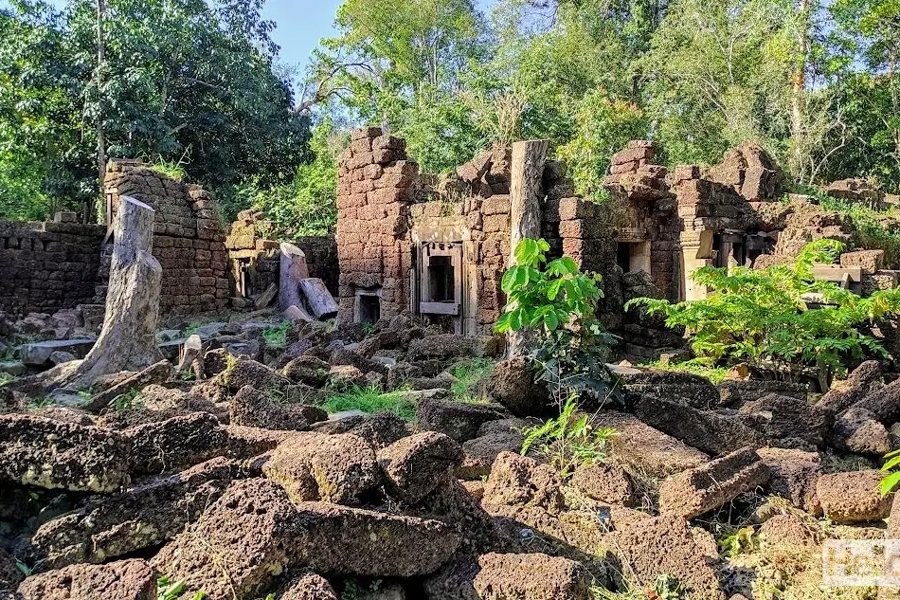Phnom Kulen National Park

Phnom Kulen National Park, situated approximately 48 kilometers north of Siem Reap in Cambodia, is a site of profound cultural, historical, and natural significance. Revered as the "Mountain of Lychees," Phnom Kulen holds religious importance and played a pivotal role in the birth of the Khmer Empire. The park features picturesque waterfalls, notably the renowned Phnom Kulen waterfall, and is adorned with ancient temples and ruins, such as Prasat Krau Romeas and the reclining Buddha statue at Prasat Beng Mealea. The water from Phnom Kulen is considered sacred, with carved stone artifacts from the Angkor period lining the riverbed. Rich in biodiversity, the park encompasses dense forests and offers recreational activities like trekking and hiking. Phnom Kulen National Park stands as a testament to Cambodia's cultural heritage, and conservation efforts strive to protect its natural and historical treasures for future generations. Visitors are encouraged to approach the site with respect for its cultural and religious significance and adhere to guidelines promoting environmental preservation.
Phnom Kulen encapsulates a history deeply intertwined with the cultural and political tapestry of the region. In the 9th century, King Jayavarman II proclaimed independence from Java on this sacred mountain, a momentous event that marked the foundation of the Khmer Empire. Throughout the subsequent Angkor period, spanning from the 9th to the 15th centuries, the area around Phnom Kulen witnessed the construction of significant temples and religious monuments that contributed to the flourishing Khmer civilization. Despite periods of civil unrest, such as during the Khmer Rouge regime in the 20th century, efforts have been undertaken to preserve the site's rich cultural and natural heritage. Henri Mouhot's 19th-century rediscovery of the ruins heightened global interest in Angkor's archaeological treasures. In the contemporary era, Phnom Kulen has emerged as a popular tourist destination, drawing visitors with its waterfalls and ancient temples. Ongoing conservation initiatives aim to balance tourism with the protection of the park's biodiversity, ensuring that Phnom Kulen remains a testament to Cambodia's enduring connection to its ancient past.
Phnom Kulen National Park boasts a variety of attractions, blending natural beauty, cultural significance, and historical charm
Phnom Kulen Waterfall: The Phnom Kulen waterfall is a major highlight, cascading over rocks and creating a picturesque setting. Visitors can swim in the pools formed by the waterfall, and the surrounding scenery adds to the allure.

This enchanting waterfall is known for its serene beauty
River of a Thousand Lingas: The Kbal Spean area in Phnom Kulen is known as the "River of a Thousand Lingas." Carvings of Hindu gods and sacred symbols adorn the riverbed, and the site holds religious importance.

The River of a Thousand Lingas is a remarkable archaeological and religious site
Prasat Beng Mealea: This temple, often referred to as the "lotus pond" temple, is an impressive archaeological site. It features a reclining Buddha statue carved into a massive sandstone boulder, adding a unique element to the historical landscape.

Prasat Beng Mealea - The architectural prowess and historical richness of the Khmer Empire
Prasat Krau Romeas: A collection of small temples, Prasat Krau Romeas provides insight into the ancient architectural and religious practices of the region. The site is surrounded by lush greenery, adding to its serene ambiance.

Prasat Krau Romeas - A collection of small temples historical and cultural significance
Bat Chum: Bat Chum is a set of three brick towers dating back to the 10th century. These ancient structures provide a glimpse into the architectural and artistic achievements of the Khmer Empire.

The temple characterized by sandstone construction, intricate carvings
Preah Ang Thom: Preah Ang Thom is a temple housing a massive, reclining Buddha carved into a sandstone boulder. This sacred site is a place of worship and pilgrimage for locals.

Preah Ang Thom holds cultural and spiritual importance of Siem Reap
Srah Damrei (Elephant Pond):Srah Damrei is a pond with a sculpture of elephants on its southern edge. The area is not only historically interesting but also a peaceful spot for visitors to enjoy the natural surroundings.
.jpg)
The site is characterized by a pond adorned with a unique sculpture of elephants
These attractions collectively make Phnom Kulen National Park a multifaceted destination, appealing to those interested in history, culture, nature, and adventure. Visitors can explore the diverse facets of Cambodia's heritage while immersing themselves in the scenic wonders of the park.
Local Transportation: If you're arriving in Siem Reap, you'll need transportation to Phnom Kulen National Park. Options include hiring a taxi, taking a tuk-tuk, or joining a guided tour. Taxi fares might range from $20 to $50, while tuk-tuks can be more affordable, depending on negotiation skills. Joining a guided tour could cost anywhere from $30 to $100 or more, depending on the inclusions.
Accommodation: Accommodation costs in Siem Reap vary widely. Budget guesthouses might offer rooms for $15 to $30 per night, mid-range hotels may charge $50 to $150, and luxury resorts can range from $150 to $500 or more per night.
Food and Dining: Cambodia is known for its affordable street food and local restaurants. Street food meals can cost as little as $1 to $3, while dining at mid-range restaurants may range from $10 to $20 per person. Upscale dining establishments may charge $30 and above.
Entrance Fees and Tours: Entrance fees to Phnom Kulen National Park may vary, the fee was around $20. Guided tours that include transportation, entrance fees, and possibly meals can range from $30 to $100 or more, depending on the tour package and the duration.
The best time to visit Phnom Kulen National Park, and Cambodia in general, depends on weather preferences and the type of experience you are seeking. Cambodia has a tropical climate with distinct wet and dry seasons.
The wet season can be a great time to visit if you want to see the waterfalls at their most powerful and experience Cambodia's lush, green scenery. However, be prepared for rain and muddy conditions.
The dry season is ideal for those who prefer more predictable weather and want to engage in activities like hiking and exploring historical sites without the challenges of heavy rainfall.
To journey to Phnom Kulen National Park, the first step involves international travel to Cambodia, specifically arriving at Siem Reap International Airport. Once in Siem Reap, travelers can secure local transportation, such as taxis or tuk-tuks, to reach the town center. Siem Reap offers a diverse range of accommodations to suit various preferences and budgets. To proceed to Phnom Kulen National Park, individuals can hire local transportation, including taxis or tuk-tuks, for a journey lasting approximately 1.5 to 2 hours. Upon reaching the park, visitors may be required to pay an entrance fee, which is subject to change. Exploring Phnom Kulen offers a captivating experience with its waterfalls, temples, and historical sites. It is advisable to check travel regulations, negotiate transportation fees in advance, and plan visits during the dry season for optimal conditions.
Experience the ultimate adventure with our Siem Reap Trekking Tour 3 Days: Phnom...
Embark on Siem Reap Trekking Tour 3 Days: Explore Siem Reap with Asia King Trave...